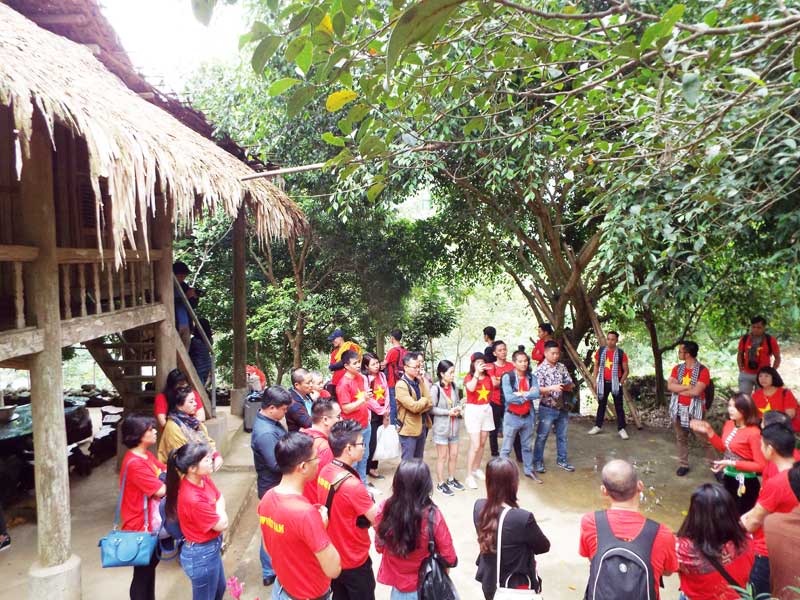
HBO - On June 22, 2017, the Party Committee of Hoa Binh province issued Resolution No.14-NQ/TU on the development of Hoa Binh lake into a national tourist area. Hoa Binh newspaper ran an interview with Director of the provincial Department of Culture, Sports and Tourism Bui Thi Niem on the issue
 Da Bia community-based
tourist site in Tien Phong commune, Da Bac district brings exciting experience
to tourists visiting Hoa Binh lake.
Da Bia community-based
tourist site in Tien Phong commune, Da Bac district brings exciting experience
to tourists visiting Hoa Binh lake.
Reporter: Could you tell
more about tourism development potential of Hoa Binh lake?
Bui Thi Niem: Hoa Binh lake
is the largest artificial lake in Southeast Asia,
stretching 70km and covering 17 communes in five districts and city. It has 47
islands and islets, including 11 karst islands sprawling over 116ha and 36 mountain
islets covering nearly 160ha.
Apart from possessing charming
and poetic landscape, the lake area is imbued with distinctive cultures of such
ethnic groups as Muong, Tay, Dao, Thai, which
are opportunities to develop discovery, resort and community-based tourism.
Sitting in a special
geographical location, Hoa Binh lake lies in a tourism centre in the north,
neighboring Hanoi
and adjacent provinces, offering an edge to attract tourists.
Reporter: Could you please
elaborate key contents of the provincial Party Committee’s Resolution
No.14-NQ/TU on the development of Hoa Binh lake into a national tourist area?
Bui Thi Niem: The
provincial Party Committee’s Resolution No.14-NQ/TU set the goal of helping Hoa
Binh lake area initially meet the criteria required for a national tourist area
by 2020. Later by 2030, Hoa Binh lake tourist area will be turned into a
national tourist one with synchronous and modern technical infrastructure,
diverse and high-quality tourist products imbued with ethnic cultures, becoming
the largest tourist centre in Hoa Binh province and one of the 12 key tourist
areas in the northern midland region with discovery tours to experience the Muong
culture in combination with Hoa Binh lake ecological system.
The resolution set the goal
that Hoa Binh lake will welcome about 630,000 visitors by 2020; nearly 1
million by 2025; and roughly 1.6 million by 2030, including 90,000 foreigners.
Tourism revenue will near 200 billion VND by 2020, around 580 billion VND by
2025, and some 1.8 trillion VND by 2030.
Reporter: Thank you very
much!
A diverse chain of eco-tourism and resort destinations concentrated in Hoa Binh city and the districts of Tan Lac, Da Bac, and Luong Son… Along with the launch of several key high-quality resort tourism projects, these developments have reshaped the landscape and enhanced the appeal of Hoa Binh as a travel destination.
Boasting diverse terrain, a mild climate, and rich natural resources, Cao Phong district is increasingly asserting its place on Vietnam’s tourism map, attracting both domestic and foreign visitors. The district is renowned for its stunning landscapes, majestic mountains, a crystal-clear hydropower lake, and the unique cultural identity of local ethnic groups.
With its pristine landscapes, unique cultural heritage of Muong ethnic minority, and an expanding range of visitor experiences, Tan Lac district of Hoa Binh has fast become a captivating destination for both domestic and international tourists.
Until now, Sung village in Cao Son commune, Da Bac district remains the only Dao ethnic community in Hoa Binh province to develop a community-based tourism model. Beyond its untouched natural landscapes, cultural identity serves as the cornerstone attraction for visitors.
Alongside the diverse cultural identities of the Kinh, Muong, Tay, Thai, Dao, and Mong ethnic people, Hoa Binh province is also renowned as the "capital" of the northwestern Vietnamese cuisine, offering unique and distinctive dishes. At festivals, during Lunar New Year (Tet), or on significant family or community occasions, special dishes are prepared, leaving a lasting impression on visitors.
A Phong Linh (Yellow Tabebuia) flower garden in Thang village, Thach Yen commune, Cao Phong district is currently in full bloom, drawing a large number of visitors.



 Da Bia community-based
tourist site in Tien Phong commune, Da Bac district brings exciting experience
to tourists visiting Hoa Binh lake.
Da Bia community-based
tourist site in Tien Phong commune, Da Bac district brings exciting experience
to tourists visiting Hoa Binh lake.